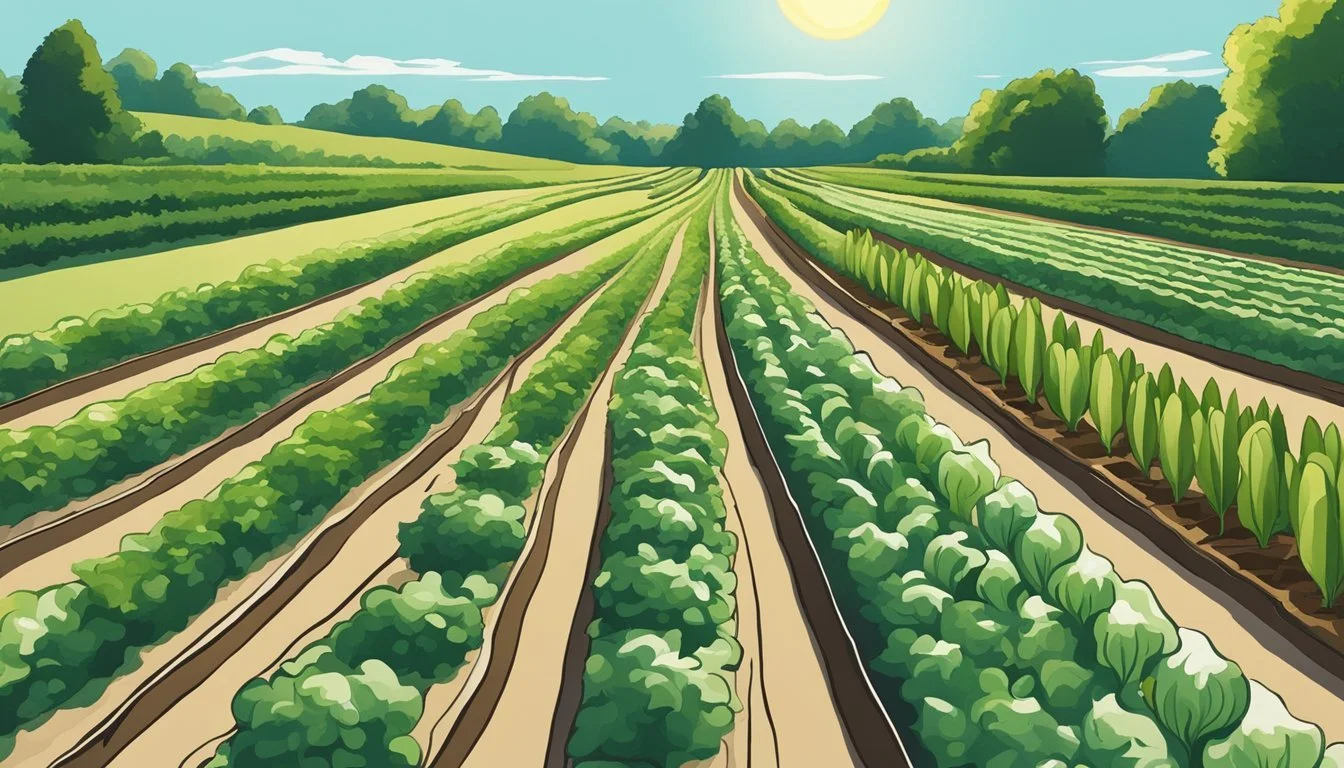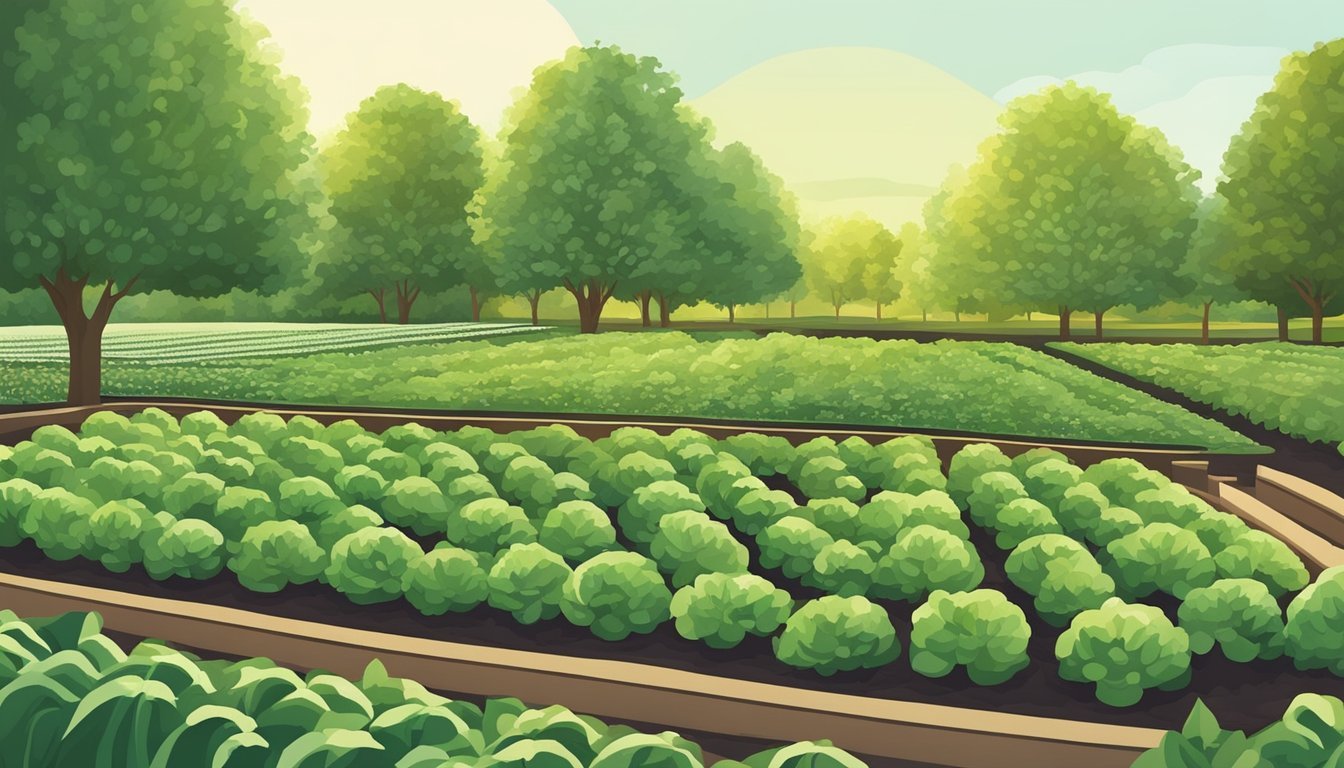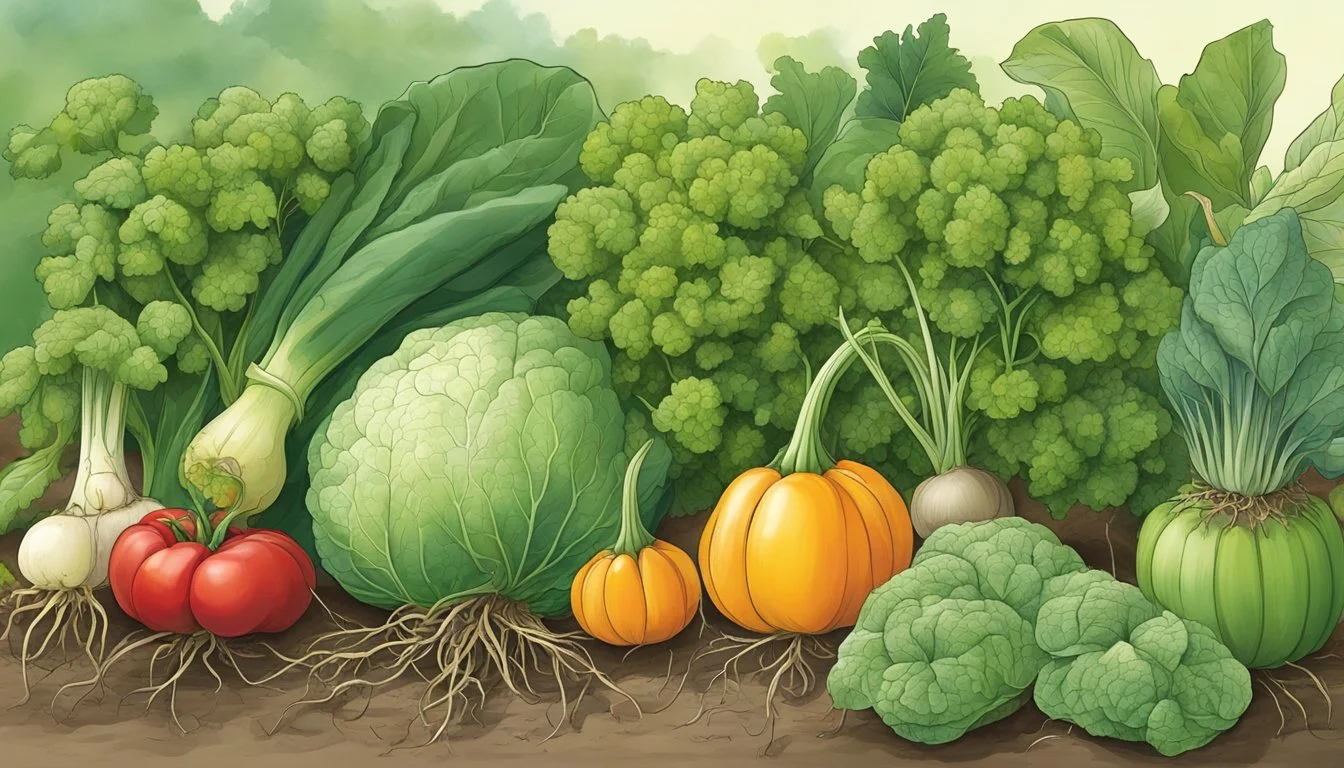Vegetable Gardening in Ohio
A Seasonal Guide for Successful Harvests
This Article is Part of Our Guide on Vegetable Gardening by State
Vegetable gardening in Ohio presents a unique set of opportunities and challenges, largely owing to the state's diverse climate and seasons. With USDA plant hardiness zones ranging from 5 to 6, Ohio gardeners must plan carefully to ensure their vegetables flourish. The state experiences cold springs and cooler fall months, which are perfect for certain cold-hardy vegetables such as lettuce, a favored crop that can tolerate frost and even light snow.
Knowledge of the region's last and first frost dates is crucial for planting as it affects both seed sowing and transplanting times. Ohio's soil temperature plays a significant role in the success of various vegetables, with some preferring warmer soils around 75 degrees Fahrenheit. These include heat-loving varieties like tomatoes, peppers, and eggplants (What wine goes well with eggplant?) that are often started indoors or as transplants to extend their growing season.
Garden planning must also take into account low-maintenance plants that are well-suited to Ohio's conditions. Lettuce, for example, is not only cold-resistant but also requires minimal maintenance, making it an excellent choice for both novice and experienced gardeners. Such strategic selections enable a productive vegetable garden that can yield fresh, homegrown produce through much of the year.
Understanding Ohio's Gardening Climate
Ohio's climate presents unique opportunities and challenges for gardeners. It's characterized by four distinct seasons, each playing a pivotal role in the gardening calendar.
Seasonal Overview
Spring: In Ohio, early spring can bring unpredictable weather, with soil temperatures gradually warming up. Gardeners must remain vigilant as frosts can occur late into the season.
Summer: The summers are typically warm and conducive for growing a wide range of vegetables. However, gardeners should ensure adequate watering during hotter periods.
Fall: As summer wanes, the fall provides a second planting window for many crops. Mild temperatures and fewer pests make for excellent growing conditions, although gardeners should prepare for early frosts.
Winter: During winter, the soil rests; however, winter planning can set the stage for a successful spring.
Hardiness Zones
Ohio spans several USDA Plant Hardiness Zones, from 5b to 7a. Most of Ohio falls within Zone 6.
Temperature Table
Season Ideal Soil Temperature Spring Above 40°F (4°C) Summer 65°-75°F (18°-24°C) Fall Above 50°F (10°C)
Gardeners should monitor these temperatures to maximize plant health and productivity.
Frosts: Gardeners must be aware of frost dates. Ohio's last spring frost typically occurs by mid-May, whereas the first fall frost can be expected around late September or early October.
Understanding Ohio's gardening climate allows gardeners to navigate through the seasons strategically, optimizing their yields and enjoying the vibrant horticulture that the state's weather patterns support.
Preparing the Garden Space
To ensure a thriving vegetable garden, they must carefully prepare the space, examining soil quality, selecting an optimal location, building suitable structures, and establishing a reliable irrigation system.
Analyzing Soil Conditions
One begins by testing the soil in their chosen garden area to determine pH levels and nutrient content. Ohio soils often lean toward clay which retains moisture but may require amendment to improve aeration and drainage. Incorporating organic matter like compost can enhance the soil structure and fertility.
Choosing the Right Location
The location of a garden is paramount for vegetable growth. A selection should be made where the garden receives a minimum of 8 hours of sunlight daily. Proximity to a water source and protection from strong winds are also considerations. Those limited on space might opt for raised bed gardening to maximize their growing area.
Building Raised Beds
Raised bed gardening is an effective method to circumnavigate challenging soil conditions. By constructing raised beds, one can fill them with a custom potting mix that caters to the specific needs of their vegetables. This setup aids in soil warming and provides excellent drainage, which is particularly helpful for crops like tomatoes and cucumbers (how long do cucumbers last?).
Making Compost
Compost acts as a soil conditioner, adding vital nutrients back into the garden's ecosystem. One can create compost by combining green waste, such as kitchen scraps, with brown waste such as dried leaves or cardboard. Regularly turned and maintained compost will decompose into rich matter ready for application.
Implementing Irrigation Systems
Efficient watering is vital, and many gardeners find drip irrigation to be the most effective method. Drip irrigation conserves water by directing it to the base of plants, reducing the spread of disease caused by overhead watering. If one's garden space doesn't allow for such a system, diligent mulching can help maintain soil moisture in between watering sessions.
Planning Your Vegetable Garden
Creating a thriving vegetable garden in Ohio requires careful selection of crops and understanding the local planting schedules. Succession planting can extend your harvest and maximize garden space efficiency.
Deciding What to Grow
Ohio gardeners can select from a diverse array of vegetables that are well-suited to the region’s climate. Focus on vegetables that perform well in Ohio's varied seasons:
Early Spring: lettuce, spinach, peas, kale
Late Spring: beets, carrots, cabbage, cauliflower
Summer: tomatoes, cucumbers, green beans, zucchini, corn, peppers, eggplant
Fall: radishes, pumpkins, parsnips, broccoli
Understanding Planting Schedules
Planting schedules for Ohio should align with the soil temperatures and seasonal conditions:
40-45°F: Start seeds for beets, carrots, peas, and turnips.
50°F: Swiss chard can be planted at this soil temperature.
60°F: Beans, cucumbers, squash are appropriate to plant.
75°F: Heat-loving vegetables like tomatoes, peppers, and eggplant thrive.
Refer to the following table for ideal soil temperatures:
Vegetable Ideal Soil Temperature for Planting Beets, Peas 40-45°F Swiss Chard 50°F Beans, Cucumbers 60°F Tomatoes, Peppers 75°F
Utilizing Succession Planting
Succession planting allows for a continuous supply of vegetables throughout the growing season. Here’s how to incorporate it into your plan:
Early Season: Plant cold-hardy vegetables like spinach and lettuce.
Mid-Season: After the early crops are harvested, plant beans and cucumbers.
Late Season: As the summer heat diminishes, sow seeds for fall harvests like radishes and broccoli.
Planting and Maintenance
Effective planting and regular maintenance are critical for a thriving vegetable garden in Ohio. This section lays out proven practices for the diligent gardener to optimize plant health and yield.
Sowing Seeds and Transplanting
Sowing seeds directly into the garden should be timed after the last frost date to avoid damage to sensitive seedlings. Utilize Ohio’s planting calendar for specific vegetable seeds. For many crops, starting seeds indoors and then transplanting them outdoors can ensure a head start on the growing season. Transplants should be acclimated through a process called hardening off before planting.
Watering Appropriately
Watering is most effective in the early morning or late afternoon to reduce evaporation. Implementing a drip or soaker hose irrigation system can deliver water efficiently to the roots and decrease leaf wetness, which can lead to disease. An inch of water per week is a general guideline, but individual vegetable garden needs may vary.
Applying Fertilizers
Fertilizers should be applied according to soil test recommendations. Excessive fertilizer can harm plants and the environment. A balanced N-P-K (nitrogen, phosphorus, potassium) fertilizer is often suitable for vegetable gardens, applied at planting time and as needed during the growing season.
Mulching to Conserve Moisture
Mulch conserves water, suppresses weeds, and keeps soil temperatures stable. Organic mulches such as straw or wood chips can be applied around plants. Maintain a mulch layer of about 2–3 inches to optimize moisture retention and keep it a few inches away from plant stems to prevent rot.
Pruning and Training Plants
Pruning removes diseased or excess growth, allowing plants to focus energy on producing vegetables. Training plants on trellises can improve air circulation and reduce diseases in crops like tomatoes, cucumbers, and pole beans. Use gentle ties and ensure trellises are sturdy enough to support plant growth.
Dealing with Pests and Diseases
In the realm of Ohio vegetable gardening, addressing the challenge of pests and diseases is pivotal for a thriving harvest. Gardeners often encounter a variety of insects that find garden crops appealing.
Common Pests:
Corn Earworm: These pests attack corn ears, feeding on the kernels. An effective preventive measure is to inject a mixture of corn oil and Bacillus thuringiensis (B.t.) onto the ear tip at full silk or to spray the silk with spinosad.
Aphids: Aphids are managed by washing plants with a strong spray of water to dislodge these insects. Further, applying horticultural oil, insecticidal soap, or neem offers organic control options.
Effective Practices: For prevention, certain planting strategies like avoiding very early or late planting are recommended. Additionally, one should consider:
Action Purpose Habitat Removal Eliminate places where pests can live and breed. Plant Selection Choose disease-resistant varieties. Crop Rotation Avoid planting the same vegetable in the same spot each year.
Diseases in Ohio Gardens: Diseases such as downy mildew on basil can be a concern for Ohio gardeners. It is crucial to inspect plants regularly and act swiftly at the first signs of disease. This includes removing affected parts and using appropriate fungicides if necessary. Gardeners should stay informed on the latest updates from local extension services on disease management and control measures.
Overall, a combination of vigilant garden care and smart preventive strategies can significantly mitigate the impact of pests and diseases on Ohio's vegetable gardens.
Harvesting and Storing Crops
When harvesting vegetables in Ohio, timing is crucial. Vegetables should be picked at their peak ripeness for the best flavor and nutritional content. Root crops such as carrots and beets can be left in the ground until needed, but they should be harvested before the ground freezes. Leafy greens like lettuce are best harvested in the cool hours of the morning.
After harvesting, proper storage is essential to extend the freshness and edibility of produce. Here are suitable ways to store common Ohio crops:
Tomatoes: Store at room temperature away from direct sunlight until they ripen fully. Once ripe, they can last in the refrigerator for a few days.
Peppers: Keep refrigerated in a plastic bag for up to a week.
Cucumbers: Store in the refrigerator, wrapped in plastic for up to a week.
Green Beans: Refrigerate in a plastic bag and consume within a week.
Lettuce: Wrap in paper towels, store in a plastic bag in the refrigerator crisper.
For root crops such as beets and carrots:
Remove the tops.
Store in a cool, humid place like a root cellar or a refrigerator.
Use perforated plastic bags to allow airflow and retain moisture.
It's important to check stored vegetables periodically for spoilage and use them in a timely manner. Ohio gardeners can delight in the freshness of their bountiful harvests by adhering to these storage guidelines.
Extending the Growing Season
Ohio's climate presents unique opportunities for gardeners to extend their growing season well into fall and even through winter. By implementing season extension techniques such as cold frames, hoop houses, and container gardening, one can harvest fresh vegetables beyond the typical growing calendar.
Using Cold Frames and Hoop Houses
Cold Frames are transparent-roofed enclosures built low to the ground, used to protect plants from extreme cold and wind. By admitting sunlight and preventing heat escape, these structures can create a microclimate that is a few degrees warmer than the external environment. Gardeners in Ohio utilize cold frames to kickstart the growth of cold hardy vegetables in early spring and to extend the fall growing season.
Hoop Houses, also known as high tunnels, are larger than cold frames and can extend the growing season by several weeks. They function as semi-permanent greenhouses, where one can grow crops like spinach, kale, and root vegetables during fall and winter. Hoop houses collect and retain heat during the day, providing warmth to the plants at night, thereby reducing the risk of frost damage.
Practicing Fall and Winter Gardening
Fall and winter gardening in Ohio revolves around selecting cold hardy vegetables that can withstand cooler temperatures. Planting these crops during the appropriate soil temperature periods in late summer or early fall allows the gardener to yield a successful harvest before the first frost. Root vegetables and leafy greens such as beets, carrots, and collards thrive during Ohio's fall.
Winter gardening often involves choosing the right varieties that can survive the harsher conditions. Utilizing mulches and row covers along with cold frames and hoop houses can protect these plants from freezing temperatures and wind, providing fresh vegetables throughout the winter months.
Growing in Containers and Vertical Spaces
Containers offer an adaptable solution for growing vegetables in spaces that might not typically be used for gardening. They allow one to easily manage the soil quality, move plants to optimize sunlight, and guard against soil-borne diseases. Pots and other containers are ideal for growing herbs and smaller vegetables like lettuce or radishes, both during the early spring and late into fall.
Vertical gardening maximizes limited space by growing plants on walls, trellises, or other vertical structures. This method is particularly effective for crops that benefit from the air circulation and reduced ground pest exposure. Whether it's utilizing a sunny wall in the fall or outfitting a balcony space in the spring, vertical gardening is a versatile approach for extending the growing season in Ohio.
Special Topics in Ohio Gardening
Ohio presents unique opportunities and challenges for gardeners, from cultivating organic produce to maximizing yields in urban spaces. The region benefits from resources and institutions like Ohio State University that provide education and support for horticultural endeavors.
Organic Vegetable Gardening
When it comes to organic vegetable gardening in Ohio, the focus is on improving soil health with natural methods. Gardeners often incorporate organic matter like compost to ensure soil is rich in nutrients. This practice supports healthy plant growth without the use of synthetic fertilizers. Ohio State University offers guidance on organic practices through its Extension service, outlining steps for soil preparation, pest management, and organic certification processes.
Urban Gardening Challenges
Urban gardeners in Ohio typically confront the issue of limited garden space. Creative solutions involve vertical gardening and container gardening to make the most of small areas. Urban gardeners also grapple with soil contamination; hence, raised beds filled with clean topsoil and organic matter are recommended. Ohio cities host community gardens, which offer additional space and collective resources for urban dwellers.
Gardening Resources and Education
Ohio provides a wealth of gardening resources and education for gardeners at all levels. Ohio State University is a hub for horticultural knowledge, offering workshops, fact sheets, and garden planning tools through its Extension program. Local county extension offices are invaluable in offering soil testing services, planting calendars, and region-specific gardening advice. Gardeners can also join horticulture clubs and societies to exchange knowledge and experience with peers.
Regional Considerations
When gardening in Ohio, understanding regional specifics is paramount for successful vegetable cultivation. Gardeners must consider variations in climate, soil, and frost dates that can significantly vary across Ohio's cities.
Climate Zones: Ohio spans USDA hardiness zones 5 and 6. This affects planting schedules, as southern cities like Cincinnati experience a slightly warmer climate than northern regions such as Cleveland or Lorain.
First & Last Frost Dates: Dayton and Columbus gardeners typically adhere to local frost dates. These dates dictate the ideal window for planting frost-sensitive and hardy vegetables.
City Estimated Last Frost Estimated First Frost Cincinnati April 15th October 15th Columbus May 5th October 5th Akron May 12th October 2nd
Soil Conditions: Toledo's proximity to the lake may affect soil moisture differently than the more inland soil of Youngstown. A soil test is recommended for accurate amendment.
Temperature Variations: Akron may have cooler spring temperatures than Dayton. It requires gardeners to wait for the soil to warm before planting heat-loving veggies.
Urban Microclimates: Cities like Cleveland can have warmer microclimates due to urban structures retaining heat, which can slightly extend the growing season.
Gardeners are advised to tailor their gardening strategies based on these regional differences. They should research specific requirements for their area to improve their chances of a bountiful harvest.
Conclusion
Vegetable gardening in Ohio presents a promising opportunity for residents to cultivate a variety of produce. Gardeners should consider both the climate and soil conditions unique to the region to ensure successful yields. The state's variable weather patterns require attention to timing for planting and harvesting.
Key considerations for Ohio gardeners include:
Climate: Ohio's growing season typically starts with cool-season crops in early spring.
Soil: Proper drainage and fertility are critical for healthy vegetables.
A selection of vegetables known to thrive in Ohio includes:
Lettuce
Spinach
Radishes
Eggplant
Kale
To maximize garden performance, stepping up against challenges such as extreme weather, pests, and diseases is advised. Despite setbacks in the past, such as in 2019, Ohioans remain resilient in their gardening efforts. чт
For optimal spacing and plant health, especially for crops like radishes, adequate spacing must be maintained, ensuring they develop to their full potential in both size and flavor.
GardenPro's suggested timing for planting can't be pinpointed to an exact date due to the variability in seasonal conditions; however, maintaining a flexible planting schedule is beneficial. Regular monitoring and adjustments according to real-time weather patterns are crucial for a productive garden.
In essence, with attentive care and a strategic approach, vegetable gardening in Ohio is both attainable and rewarding.









